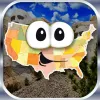Take a look inside 5 images
Stack the States
Pros: Fast-paced games and engaging visuals hold kids' interest on a topic that can get repetitious.
Cons: If a kid doesn't enjoy stacking, even if they like answering the questions, the stacking may be too frustrating.
Bottom Line: Sharp-looking and engaging game coupled with flashcards motivates kids to memorize states and capitals.
Stack the States is a good tool for teachers to use with students to help them memorize the names of U.S. states and capitals. It works well with reluctant learners who may be motivated by mixing those need-to-know facts with more interesting trivia and fast-paced gameplay. The states become animated characters, with eyes that follow your motions, and because they're so adorable, they'll inspire some kids to play more.
Up to six students can have individual user accounts to save progress and settings on Stack the States. But groups of students could take turns answering questions and earning states. For younger students using this app, have them trace larger versions of some states and then draw in characteristics that represent the facts they've learned on this app (a cowboy hat on Texas, or sunshine eyes on Florida).
Editor's Note: There's a sequel to Stack the States called Stack the States 2.
Stack the States is a unique U.S. geography app that helps kids learn and recall America's states and capitals. Kids can study the information first, using in-app flashcards. Each state's flashcard includes information about postal abbreviation, capital city, nickname, border states, major cities, landmarks (some states don't have any listed), and whether it borders Canada or Mexico. If flashcards aren't your students' favorite thing, they can learn by simply playing the games on Stack the States. The games ask trivia questions about a state or ask kids to identify the shape of the state. When kids answer correctly, they earn that state to stack on a platform. The goal is to stack as many states on the platform as necessary to reach a goal line without the pile tipping over. When kids reach the goal, their reward is a state to add to their collection. As the collection grows, kids earn bonus games. Most of the bonus games are timed and can feel frenzied; "Puzzler" and "Capital Drop" are both quite tricky, even on lower levels.
This fun app is good for learning and practicing geography questions about the United States. The main game about stacking the states has a Jenga-type feel to it as you try to balance all the oddly shaped states on top of each other. This stacking part of the games is the most fun but the least educational part of the app from a geography perspective. It does exercise spatial awareness skills, but it can also be a bit frustrating for some students. If players don't rotate and line up the states to drop on the stack just so, the piece falls off and you lose it. The good news for learning is that when that happens, kids return to answering more questions about geography in order to earn another state.
With smiling state icons and beautiful photo images of national landmarks in the background, Stack the States keeps kids' visual focus on the shapes and names of the states. Up to six students (and unlimited guest users) can have individual user names and save different game settings.












